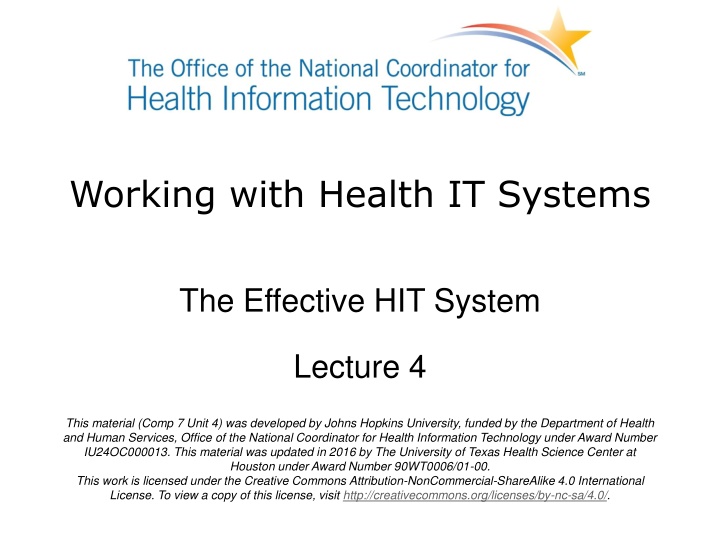
Understanding Effective HIT Systems in Health IT - Characteristics and Benefits
Learn about the key characteristics and benefits of effective Health IT systems, including evidence-based practice support, scalability, usability, and more. Explore how HIT systems facilitate best practices and improve patient care outcomes.
Download Presentation

Please find below an Image/Link to download the presentation.
The content on the website is provided AS IS for your information and personal use only. It may not be sold, licensed, or shared on other websites without obtaining consent from the author. If you encounter any issues during the download, it is possible that the publisher has removed the file from their server.
You are allowed to download the files provided on this website for personal or commercial use, subject to the condition that they are used lawfully. All files are the property of their respective owners.
The content on the website is provided AS IS for your information and personal use only. It may not be sold, licensed, or shared on other websites without obtaining consent from the author.
E N D
Presentation Transcript
Working with Health IT Systems The Effective HIT System Lecture 4 This material (Comp 7 Unit 4) was developed by Johns Hopkins University, funded by the Department of Health and Human Services, Office of the National Coordinator for Health Information Technology under Award Number IU24OC000013. This material was updated in 2016 by The University of Texas Health Science Center at Houston under Award Number 90WT0006/01-00. This work is licensed under the Creative Commons Attribution-NonCommercial-ShareAlike 4.0 International License. To view a copy of this license, visit http://creativecommons.org/licenses/by-nc-sa/4.0/.
The Effective HIT System Learning Objectives Identify characteristics of an effective HIT system. Define and provide examples of how evidence-based practice can be supported in HIT systems. Define and cite examples of usability, configurability, scalability, and reliability in HIT systems. List and contrast different types of reports/queries (predefined vs. ad hoc) required for internal and external reporting. 2
Effective HIT Integrated/Interactive exchange Patients, providers, government agencies, insurers Increase of overall quality, safety, efficiency, decreased costs, & increased patient access Improved public health Early detection of outbreaks Tracking & evaluation in chronic disease Post-marketing surveillance of medications Evaluation/reimbursement based on value 3
Characteristics of Effective HIT Flexible Adaptable Configurable & Agile Dependable/Reliable Useable Scalable 4
Facilitates Best Practices Evidence Based Practice (EBP) the integration of best-researched evidence and clinical expertise with patient values. (Crossing the Quality Chasm, 2001) Guideline-enhanced Care http://www.guideline.gov/ 5
Medication Reconciliation Process of determining what medications patient is taking Med errors Admissions Transfers Discharge Polypharmacy Bar Code Medication Administration (BCMA) & e-MAR E-prescribing & digital medication records CC BY-NC-ND 2.0 by Laura 6
Supporting Workflow HIT organizes work, integrates knowledge, supports decision-making Decreased memory demands Routing and prioritizing 7
Automating Workflow Automates tedious aspects Effective use of resources balancing supply and demand 8
Extracting Data Data extraction & reporting Ad hoc & pre-defined User centered design a design and evaluation process that pays particular attention to the intended users, what they will do with the product, where they will use it, and what features they consider essential (ISO 13407) 9
The Effective HIT System Summary Identify characteristics of an effective HIT system. Define and cite examples of usability, configurability, scalability and reliability in HIT systems. Define and provide examples of how evidence- based practice can be supported in HIT Systems. List and contrast different types of reports/queries (predefined vs. ad hoc) required for internal and external reporting. 10
he Effective HIT System References References Crossing the Quality Chasm: A New Health System for the 21st Century. (2001). Institute of Medicine of the National Academies. Available from: http://www.iom.edu/Reports/2001/Crossing-the-Quality-Chasm-A-New- Health-System-for-the-21st-Century.aspx Dennison J, Eisen S, Towers M, & Clark CI. (2006). An Effective Electronic Surgical Referral System. Annals of The Royal College of Surgeons of England. 88(6): 554-556 Available from: http://www.ncbi.nlm.nih.gov/pmc/articles/PMC1963768/?tool=pubmed Gibbons R, Antman E, & Smith S. (2010). Has guideline development gone astray? No. British Medical Journal, 340:c343. ISO 13407. (1999). Human Centered Design Processes for Interactive Systems. Available at: http://www.iso.org/iso/catalogue_detail.htm?csnumber=21197 National Guideline Clearinghouse. Agency for Healthcare Research and Quality. Available from: http://www.guideline.gov/ Webster L, & Shapiro R. (2010). Health information technology: A new world for pharmacy. Journal of the American Pharmacists Association. 2010 April; 50(2): e20-e34. Available from: http://japha.metapress.com/openurl.asp?genre=article&id=doi:10.1331/JAPhA.2010.09170 Lowry, S. Z., Ramaiah, M., Patterson, E. S., Brick, D., Gurses, A. P., Ozok, A., ... & Gibbons, M. C. (2014, March). Integrating Electronic Health Records into Clinical Workflow An Application of Human Factors Modeling Methods to Ambulatory Care. Retrieved from http://nvlpubs.nist.gov/nistpubs/ir/2014/NIST.IR.7988.pdf Module 5. Mapping and Redesigning Workflow. May 2013. Agency for Healthcare Research and Quality, Rockville, MD. http://www.ahrq.gov/professionals/prevention-chronic-care/improve/system/pfhandbook/mod5.html Definition of polypharmacy. http://www.merriam-webster.com/dictionary/polypharmacy. 11
The Effective HIT System References Images Slide 3: U.S. Public Health Service Logo. Available from: http://www.usphs.gov/ Slide 4: Hands on Keyboard. Creative Commons Image Source . CC BY 2.0 by Mike Traboe. Available from: http://www.flickr.com/photos/mtraboe/3553065659/sizes/m/in/photostream/ Slide 5: Personal Screenshot. Available from: http://www.iom.edu/Reports/2001/Crossing-the-Quality-Chasm-A- New-Health-System-for-the-21st-Century.aspx Slide 6: Image 1: Pills. Available from: http://www.flickr.com/photos/silverlinedwinnebago/1405216080/sizes/m/in/photostream/ Attribution-NonCommercial-NoDerivs 2.0 Generic (CC BY-NC-ND 2.0) SilverlinedWinnebago Image 2: Arm Band. Veterans Administration. Available from: http://www.houston.va.gov/pressreleases/news_20020910a.asp Slide 7: Workflow Diagram. Available: http://www.flickr.com/photos/fenng/32621244/sizes/m/in/photostream/ David Feng. Attribution-NonCommercial-ShareAlike 2.0 Generic (CC BY-NC-SA 2.0) Slide 8: Balancing Rocks. Available: http://www.flickr.com/photos/preef/269412566/ . Tony Roberts Attribution-NonCommercial-ShareAlike 2.0 Generic (CC BY-NC-SA 2.0) Slide 9: Happy Computer. Available: http://1.bp.blogspot.com/_aVKglbYugv4/SGCZi7FPoKI/AAAAAAAAAuo/ qvcEPbaIcMY/s1600-h/happy+computer.jpg. CC BY-NC-SA 2.0 by Cyclone's Sketchblog. 12
Working with Health IT Systems The Effective HIT System This material was developed by Johns Hopkins University, funded by the Department of Health and Human Services, Office of the National Coordinator for Health Information Technology under Award Number IU24OC00013. This material was updated in 2016 by The University of Texas Health Science Center at Houston under Award Number 90WT0006. 13






















